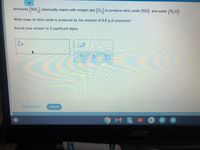
Concept explainers

Solution
Ammonia, as AN verdant and low-cost resource, is commonly adopted within the nitridation method. additionally, a number of studies rumored that gas vacancies (OVs) may be shaped in N-doping transition metal oxides (TMOs) throughout ammonia treatment. However, the mechanism still lacks elementary understanding. Thus, it's of interest to check the character of ammonia treatment. Herein, we have a tendency to reveal that the H and N atoms will extract O atoms in WO3 to make liquid, N2, N2O, and NO in ammonia treatment. Meanwhile, WO3 square measure born-again consecutive into WO3−x and WN. supported this mechanism, we have a tendency to gift a universal low-temperature ammonia-assisted reduction strategy to synthesize OV-enriched TMOs while not N-doping. curiously, the as-prepared OV-enriched blue WO3−x porous nanorods (OBWPN) and Nb2O5−x show increased photocatalytic performance thanks to the existence of OVs. This work provides a elementary mechanism study of ammonia treatment and opens a replacement perspective on the look of OV-enriched TMOs with increased performance.
Trending nowThis is a popular solution!
Step by stepSolved in 2 steps with 1 images

- Ammonia NH3 chemically reacts with oxygen gas O2 to produce nitric oxide NO and water H2O. What mass of nitric oxide is produced by the reaction of 9.91 g of ammonia? Round your answer to 3 significant digits.arrow_forwardAmmonium phosphate ((NH) PO, is an important ingredient in many fertilizers. It can be made by reacting phosphoric acid (H, PO,) with ammonia (NH,). What mass of ammonium phosphate is produced by the reaction of 7.93 g of ammonia? Round your answer to 3 significant digits.arrow_forward回 回 山回 国口 Liquid octane (CH,(CH,) CH; will react with gaseous oxygen (0,) to produce gaseous carbon dioxide (CO,) and gaseous water (H,O). Suppose 9.1 g of octane is mixed with 50.6 g of oxygen. Calculate the minimum mass of octane that could be left over by the chemical reaction. Round your answer to 2 significant digits.arrow_forward
- Gaseous ethane (CH,CH,) will react with gaseous oxygen (O,) to produce gaseous carbon dioxide (CO,) and gaseous water (H,0). Suppose 14.4 g of ethane is mixed with 37. g of oxygen. Calculate the maximum mass of carbon dioxide that could be produced by the chemical reaction. Round your answer to 2 significant digits.arrow_forwardAmmonia (NH,) chemically reacts with oxygen gas (0,) to produce nitric oxide (NO) and water (H,O). What mass of water is produced by the reaction of 4.25 g of oxygen gas? Round your answer to 3 significant digits. ?arrow_forwardWhat mass of octane is consumed by the reaction of 2.13g of oxygen gas?arrow_forward
- Green plants use light from the Sun to drive photosynthesis. Photosynthesis is a chemical reaction in which water H2O and carbon dioxide CO2 chemically react to form the simple sugar glucose C6H12O6 and oxygen gas O2 . What mass of oxygen gas is produced by the reaction of 6.6g of carbon dioxide? Be sure your answer has the correct number of significant digits.arrow_forwardAmmonium perchlorate (NH,CIO, is the solid rocket fuel used by the U.S. Space Shuttle. It reacts with itself to produce nitrogen gas (N,), chlorine gas (Cl,), oxygen gas (O2), water (H,0), and a great deal of energy. What mass of water is produced by the reaction of 8.0 g of ammonium perchlorate? Round your answer to 2 significanț digits. x10 Explanation Check Privacy Cen O 2022 McGraw Hill LLC. All Rights Reserved. Terms of Use 80 F Cloudy DELLarrow_forwardAmmonia NH3 chemically reacts with oxygen gas O2 to produce nitric oxide NO and water H2O What mass of nitric oxide is produced by the reaction of 3.5 g of ammonia? Round your answer to 2 significant digits.arrow_forward
- Ammonium phosphate ((NH4) P04) is an important ingredient in many fertilizers. It can be made by reacting phosphoric acid (H,PO,) with ammonia (NH,). What mass of ammonium phosphate is produced by the reaction of 2.8 g of phosphoric acid? db Round your answer to 2 significant digits.arrow_forwardAmmonium phosphate ((NH,), PO4) is an important ingredient in many fertilizers. It can be made by reacting phosphoric acid (H,PO4) 3 with ammonia (NH,). What mass of ammonium phosphate is produced by the reaction of 5.2 g of phosphoric acid? Be sure your answer has the correct number of significant digits. x10arrow_forward
 ChemistryChemistryISBN:9781305957404Author:Steven S. Zumdahl, Susan A. Zumdahl, Donald J. DeCostePublisher:Cengage Learning
ChemistryChemistryISBN:9781305957404Author:Steven S. Zumdahl, Susan A. Zumdahl, Donald J. DeCostePublisher:Cengage Learning ChemistryChemistryISBN:9781259911156Author:Raymond Chang Dr., Jason Overby ProfessorPublisher:McGraw-Hill Education
ChemistryChemistryISBN:9781259911156Author:Raymond Chang Dr., Jason Overby ProfessorPublisher:McGraw-Hill Education Principles of Instrumental AnalysisChemistryISBN:9781305577213Author:Douglas A. Skoog, F. James Holler, Stanley R. CrouchPublisher:Cengage Learning
Principles of Instrumental AnalysisChemistryISBN:9781305577213Author:Douglas A. Skoog, F. James Holler, Stanley R. CrouchPublisher:Cengage Learning Organic ChemistryChemistryISBN:9780078021558Author:Janice Gorzynski Smith Dr.Publisher:McGraw-Hill Education
Organic ChemistryChemistryISBN:9780078021558Author:Janice Gorzynski Smith Dr.Publisher:McGraw-Hill Education Chemistry: Principles and ReactionsChemistryISBN:9781305079373Author:William L. Masterton, Cecile N. HurleyPublisher:Cengage Learning
Chemistry: Principles and ReactionsChemistryISBN:9781305079373Author:William L. Masterton, Cecile N. HurleyPublisher:Cengage Learning Elementary Principles of Chemical Processes, Bind...ChemistryISBN:9781118431221Author:Richard M. Felder, Ronald W. Rousseau, Lisa G. BullardPublisher:WILEY
Elementary Principles of Chemical Processes, Bind...ChemistryISBN:9781118431221Author:Richard M. Felder, Ronald W. Rousseau, Lisa G. BullardPublisher:WILEY





